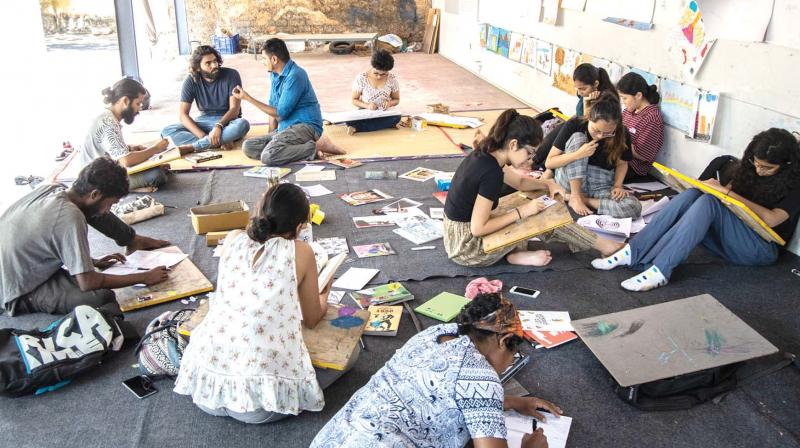How stories turn to comics

The storyboards were all interesting: buses going to different parts of the city, people waiting at the boat jetty, an auto ride around Fort Kochi, an elderly couple visiting India for the Biennale. That way, no participant at the comic-making sessions disappointed the teacher.
Artist Lokesh Khodke’s workshop Where Do People Go Every Day? at the art room explored the possibility of finding stories from one’s surroundings and shaping them into comics.
At the recently concluded classroom in the Cabral Yard venue of the Kochi-Muziris Biennale, Lokesh asked the participants to visit one of the busiest areas nearby and observe its people. “The narratives that came through the three-hour exercise were very interesting,” explains the post-graduate from the Faculty of Fine Arts at Maharaja Sayajirao University, Baroda.
While some participants brought back very specific narratives, others came out with an overview of what they had seen. “Fair enough. The idea anyway was to let the participants discover the charm of looking at the mundane and imagining things that can together generate a storyline. Observation is key. For, you can find your story at any place,” says the artist, a founding member of Blue Jackal, which is a platform for engaging with and creating visual narratives, comics and picture-books.
Pranav Prabhakaran, a participant who is an art graduate from Thiruvananthapuram, created the busy scene of the bus-stop. “I did not want to narrow my story to a single person. I tried to capture different people and their conversations at the local bus stop,” he says. “Like, how every minute a new bus will call out for people to a different destination and my interaction with people during that time.”
On the contrary, an 11th-grader from Maharashtra chose to essay a couple she saw at a café. Eunseo Son of Pune picked an elderly husband and wife as her muse for the story. “When I entered the café, I first saw a young couple having a nice vacation time. Soon after they left, the place was taken over by an elderly couple who were fighting about every little thing. I noticed that the fights apart, they were remembering their younger days and how they used to enjoy each other’s company. I got my story.”
Lokesh had his first foray into comics as a children’s book illustrator. Soon, he fell in love with the medium—one that allows “accessibility as a storytelling device”, as he notes. “Comics aren’t necessarily about drawing the accurate representation; it’s about iconography and storytelling. You have to learn how to get your audience to make inferences about the characters. What you show and what you don’t show.”
Substantiating, he says: “It’s not just what they say. It’s not just what’s in the written word. It’s also about how a character’s body language is portrayed. This workshop also aimed at teaching more about it.”
Thus, each participant created a little sketchbook using A4 sheets and produced a storyboard. Together with the master, they decided the inputs to the narrative, in the process omitting out a few. “Some of the participants used the same storyboard, while others changed the scene a little. Together, we worked on the next two days finalising the details and creating a finished product,” he says.
At the end of the workshop, each story was printed out so as to be showcased at the half-open art room. “The idea was to make the participant understand the whole process of comics making,” says Lokesh. “It does not stop with sketching or putting the text. One must know the process fully, from creating the sketch to scanning it into the computer system to using Photoshop technique for editing to the final print.”

